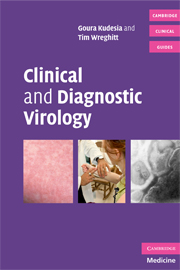Book contents
- Frontmatter
- Contents
- List of plates
- Preface
- Acknowledgements
- SECTION 1 INDIVIDUAL VIRUSES
- Introduction to virology
- 1 Adenoviruses
- 2 Arboviruses and haemorrhagic fever viruses
- 3 Cytomegalovirus (CMV)
- 4 Epstein–Barr virus (EBV)
- 5 Enteroviruses
- 6 Hepatitis A virus (HAV)
- 7 Hepatitis B and D viruses (HBV and HDV)
- 8 Hepatitis C virus (HCV)
- 9 Hepatitis E virus (HEV)
- 10 Herpes simplex virus (HSV)
- 11 Human immunodeficiency virus (HIV) and acquired immunodeficiency syndrome (AIDS)
- 12 Human herpes viruses types 6, 7 and 8 (HHV 6, 7 and 8)
- 13 Human T-cell leukaemia virus (HTLV)
- 14 Influenza viruses
- 15 Measles virus
- 16 Mumps virus
- 17 Noroviruses
- 18 Parainfluenza viruses
- 19 Papilloma and polyoma viruses
- 20 Parvovirus B19
- 21 Pox viruses
- 22 Rabies virus
- 23 Respiratory syncytial virus (RSV)
- 24 Rhinoviruses
- 25 Rotavirus
- 26 Rubella virus
- 27 SARS CoV and other coronaviruses
- 28 Varicella-zoster virus (VZV)
- SECTION 2 OTHER RELATED AGENTS
- SECTION 3 CLINICAL SYNDROMES
- SECTION 4 DIAGNOSTIC TECHNIQUES
- SECTION 5 PATIENT MANAGEMENT
- Index
- Plate section
21 - Pox viruses
Published online by Cambridge University Press: 07 December 2009
- Frontmatter
- Contents
- List of plates
- Preface
- Acknowledgements
- SECTION 1 INDIVIDUAL VIRUSES
- Introduction to virology
- 1 Adenoviruses
- 2 Arboviruses and haemorrhagic fever viruses
- 3 Cytomegalovirus (CMV)
- 4 Epstein–Barr virus (EBV)
- 5 Enteroviruses
- 6 Hepatitis A virus (HAV)
- 7 Hepatitis B and D viruses (HBV and HDV)
- 8 Hepatitis C virus (HCV)
- 9 Hepatitis E virus (HEV)
- 10 Herpes simplex virus (HSV)
- 11 Human immunodeficiency virus (HIV) and acquired immunodeficiency syndrome (AIDS)
- 12 Human herpes viruses types 6, 7 and 8 (HHV 6, 7 and 8)
- 13 Human T-cell leukaemia virus (HTLV)
- 14 Influenza viruses
- 15 Measles virus
- 16 Mumps virus
- 17 Noroviruses
- 18 Parainfluenza viruses
- 19 Papilloma and polyoma viruses
- 20 Parvovirus B19
- 21 Pox viruses
- 22 Rabies virus
- 23 Respiratory syncytial virus (RSV)
- 24 Rhinoviruses
- 25 Rotavirus
- 26 Rubella virus
- 27 SARS CoV and other coronaviruses
- 28 Varicella-zoster virus (VZV)
- SECTION 2 OTHER RELATED AGENTS
- SECTION 3 CLINICAL SYNDROMES
- SECTION 4 DIAGNOSTIC TECHNIQUES
- SECTION 5 PATIENT MANAGEMENT
- Index
- Plate section
Summary
The viruses
Orthopox and parapox viruses are double-stranded DNA viruses. They are the largest in size of all known viruses.
Introduction
Pox virus infections, with the exception of molluscum contagiosum, are very rare in the UK. Smallpox was eradicated from the world in 1977. The most commonly diagnosed infections in the UK are molluscum contagiosum, cowpox (most often acquired from cats) and orf (transmitted by sheep) and milker's node (acquired from cows). Other pox viruses, such as monkeypox, are endemic in a few tropical and sub-tropical countries, occasionally causing outbreaks in the Western world due to imported animals. All these viruses cause characteristic pustular skin lesions, which develop into large scabs that can leave permanent pock marks. These skin lesions and their distribution are different, facilitating clinical diagnosis. However, clinical diagnosis is not foolproof – with monkeypox, smallpox and chickenpox being mistaken for each other before smallpox eradication in Africa. Laboratory diagnosis used to be made by electron microscopy and via culture in embryonated eggs. Although diagnosis can still be made by electron microscopy, molecular methods, especially for pox viruses, are becoming the most commonly used.
- Type
- Chapter
- Information
- Clinical and Diagnostic Virology , pp. 94 - 97Publisher: Cambridge University PressPrint publication year: 2009



